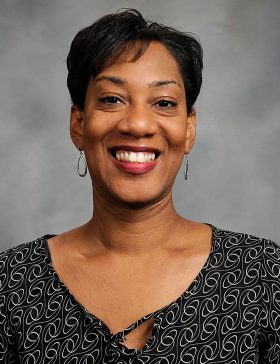Associate Professor Naeemah Clark writes in a newspaper guest column about the lack of minority female role models on television who can be a positive influence for all girls of color.
The following column appeared recently in the Annapolis (Md.) Capital, the (Greensboro, N.C.) News & Record, the (Burlington, N.C.) Times-News and the Roanoke (Va.) Times via the Elon University Writers Syndicate. Viewpoints shared by this syndicate are those of the author and not of Elon University.

By Naeemah Clark – nclark3@elon.edu
My mother applied her brown Maybelline makeup to my plastic Marie Osmond Halloween mask in 1978 because the idea that I was pretending to be a white woman was more than she could take.
After all, my parents had given me a Muslim name and there was a picture of Malcolm X hanging in our family room. They were proud to be a part of the upwardly mobile black middle class, which meant that we had a suburban home with a television set in each of the three bedrooms.
Yet when I was 5 I told my mother that my dream in life was to have Cher’s satiny black hair that cascaded all the way down her back and swished when she moved. Television offered me a powerful window to a world that focused on women who didn’t look like me.
And I so much wanted to be a part of that world. Pretty. Accepted. Validated.
I appreciated the determined resourcefulness of Florida Evans, the struggling mom from “Good Times,” but she never solved a crime while wearing great evening gown and strappy sandals like “Charlie’s Angels.”
“The Jeffersons” had a cantankerous maid, Florence, who was great for comedy but wasn’t keeping men captivated on lido deck of “The Love Boat.” Where were the beautiful brown-skinned women with short hair, broad noses, and wide hips? These women were rarely the focus of adulation or romantic love. It was clear that women that looked like me weren’t celebrated—in fact, they were largely invisible.
Television audiences have seen a few happily married African-American couples on television (Cliff and Claire Huxtable, for example), but have we seen them meet, have romances, and fall in love? Of course, this happens to African-American women, but it just doesn’t happen on television.
Negative or nonexistent depictions are problematic because television contributes to the socialization of its viewers, preparing them to play a role in the world. It is one of the many ways young people learn who they are and how they are supposed to behave. Watching television taught me that the way to be considered beautiful was to have Cher’s hair and Marie Osmond’s button nose.
So what does the upcoming fall television schedule offer for all little girls of color? Women of color only have a small share of the valuable space available during prime time. And in that space, we seem to be problem solvers who offer magical wisdom or neighbors who deliver a killer one liner and then exit with a bit of flair. Rarely are we leads in these shows.
Members of the Asian-American community are also lamenting the lack of positive images of Asian-American women. The advocacy group Media Action Network for Asian Americans recently asked the FOX network to reshoot the portrayal of an over-sexualized Asian-American young woman on “Dads,” Seth MacFarlane’s newest addition to its prime time line up.
As someone who researches and talks about the economic aspects of the television industry, I am inclined to agree with FOX’s reluctance to reshoot the episode. Television is a business and the series already has the support of advertising dollars behind it.
Audiences can vote with their remote controls and computer screens. Networks sell audience to advertisers. The entire purpose of a television program is to deliver an audience to advertisers. Each new season gives networks a chance to reach untapped advertisers with untapped audiences, but each September seems to repeat the patterns of the previous year.
As that former little girl who grew up wanting to see someone who looked like her doing something great on TV, I would like to see the networks to do better. Show runners would do well to follow the lead of Shonda Rhimes who tells commercially successful and compelling stories of women who are gay, Hispanic, African-American and who live their lives with physical limitations.
They are not perfect—no mother is going to let her 5-year-old be Olivia Pope for Halloween—but they are present. Even better, they are appealing to women who have purchasing power and a need to see their real lives reflected on their television screens.
And these stories will make a difference to all viewers.
Naeemah Clark is an associate professor of communications at Elon University and co-author of the textbook “Diversity in U.S. Mass Media.”
*****
Elon University faculty with an interest in sharing their expertise with wider audiences are encouraged to contact Eric Townsend (etownsend4@elon.edu) in the Office of University Communications should they like assistance with prospective newspaper op/ed submissions.


